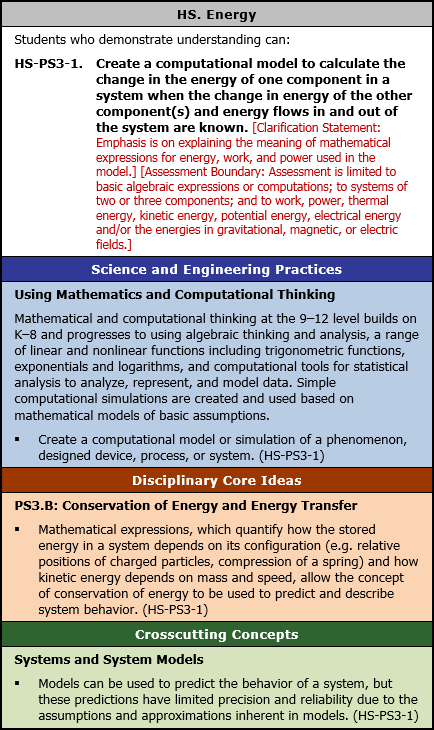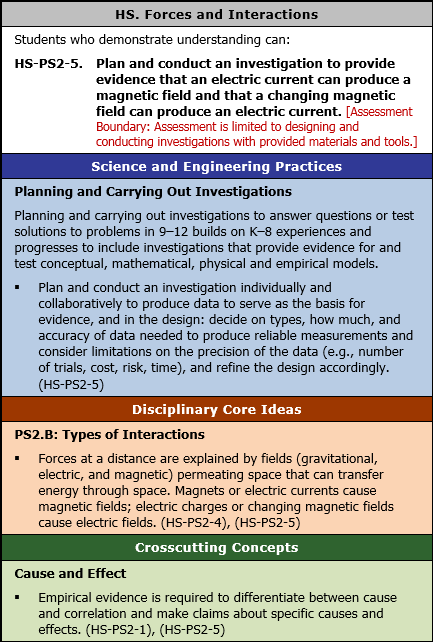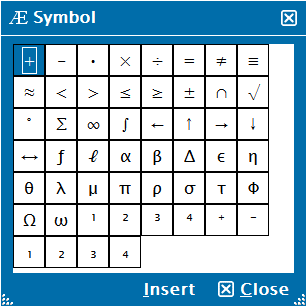Study Guide
Field 163: Physics
Recommendation for individuals using a screenreader: please set your punctuation settings to "most."
Review the special character palette available for science CSTs:
Sample Constructed-Response Item 1
Competency 0007
Pedagogical Content Knowledge
Use the following New York State P to 12 Science Learning Standard to complete the assignment below.
Using your pedagogical and content knowledge of physics, write a response of approximately 400 to 600 words in which you:
- identify a specific learning goal for the lesson;
- describe how you will assess student readiness for the lesson's learning goal;
- describe an appropriate and effective three-dimensional (i.e., disciplinary core idea, crosscutting concept, science or engineering practice) instructional strategy that you would use to help students meet the learning goal;
- explain how the instructional strategy you described will connect students' prior understanding (e.g., cultural relevancy, real-world experience) to the new knowledge related to the learning goal;
- describe a modification to the instruction that you would use and explain how it would address the strengths and/or needs of all students; and
- describe an appropriate and effective assessment related to the learning goal, in order to evaluate and promote learning and growth for all students.
Learning Standard
You are planning instruction for a high school physics class. The lesson that you are preparing to teach will address the following standard from the New York State P to 12 Science Learning Standards.1

HS. Energy
Students who demonstrate understanding can:
HS-PS3-1. Create a computational model to calculate the change in the energy of one component in a system when the change in energy of the other component(s) and energy flows in and out of the system are known. [Clarification Statement: Emphasis is on explaining the meaning of mathematical expressions for energy, work, and power used in the model.] [Assessment Boundary: Assessment is limited to basic algebraic expressions or computations; to systems of two or three components; and to work, power, thermal energy, kinetic energy, potential energy, electrical energy and/or the energies in gravitational, magnetic, or electric fields.]
Science and Engineering Practices
Using Mathematics and Computational Thinking
Mathematical and computational thinking at the 9 to 12 level builds on K to 8 and progresses to using algebraic thinking and analysis, a range of linear and nonlinear functions including trigonometric functions, exponentials and logarithms, and computational tools for statistical analysis to analyze, represent, and model data. Simple computational simulations are created and used based on mathematical models of basic assumptions.
- Create a computational model or simulation of a phenomenon, designed device, process, or system. (HS-PS3-1)
Disciplinary Core Ideas
PS3.B: Conservation of Energy and Energy Transfer
- Mathematical expressions, which quantify how the stored energy in a system depends on its configuration (e.g. relative positions of charged particles, compression of a spring) and how kinetic energy depends on mass and speed, allow the concept of conservation of energy to be used to predict and describe system behavior. (HS-PS3-1)
Crosscutting Concepts
Systems and System Models
- Models can be used to predict the behavior of a system, but these predictions have limited precision and reliability due to the assumptions and approximations inherent in models. (HS-PS3-1)
Sample Strong Response to Constructed-Response Item 1
- Students will use the conservation of mechanical energy (i.e., kinetic, potential energies) to solve problems involving energy transfers in a system in which the total energy is constant (i.e., no non-conservative forces such as friction or air resistance are present). This will be an extension of prior knowledge regarding kinematics, free-fall, and projectile motion. Describing how the changes occur qualitatively helps students build conceptual knowledge.
- Students will be given a warm-up activity to calculate potential energy and kinetic energy of given systems near the surface of the Earth. They will then share answers (or questions) with their team. Emphasis will be placed on the mathematical assessment of the energies including solving square root expressions.
- Students will record video of a falling mass from rest at a measured height near the ceiling of the class. As the video is projected, students will qualitatively describe the initial total energy (PE only) and various combinations of PE and KE as the object falls. The teacher will ask conceptual questions such as: “Where are the energies maximum or minimum or zero?" "What is the total energy of the mass along its trajectory?" The teacher will play back the video as needed. The goal is to have students understand conceptually that the energy is conserved overall and is transferred between forms.
- The video will be run backwards. Students will compare and contrast the energy changes in the mass (KE decreases as PE increases). Students will brainstorm situations that could produce the motion of the mass (e.g., spring popper, compressed-air rocket).
- Following discussion, students will be placed into groups to do mathematical problems related to the video by writing down the total energy in terms of PE and KE at various points along its trajectory. Students will calculate PE, KE, and the total energy (PE + KE) along the mass's trajectory, as well as the speed at various heights. The teacher will circulate and help students use mathematics and computational thinking, as needed.
- Students will gain more experience by using the conservation of energy to model a variety of mechanical systems such as a mass on an inclined plane, a pendulum, a person skiing down a hill, a projectile launched vertically, etc. Students will identify elements of the systems that incorporate other forms of energy (thermal, rotational) beyond linear kinetic and potential energies to better understand how the model approximates the real world.
- Students will next watch a video of a roller coaster. They will discuss the energy changes that occur, identifying points of maximum gravitational potential and kinetic energies, minimum gravitational potential and kinetic energies, and zero energy.
- Students will work in teams to design their own roller coaster. An on-line roller coaster design computer program will be available to help students visualize the project. Students will be asked to create a scale drawing of the track and to create a mathematical model in which they use conservation of energy to evaluate their designs, including safety features related to speed. Rotational dynamics can be covered here, if appropriate.
- Describing the energy changes qualitatively will help students translate a real-world situation into a mathematical model. The energy changes will be converted from regular language into mathematical representations.
- Students will present their designs to the class as a short presentation. They will be assessed on the accurate application of conservation of energy in modeling the motion of a roller coaster, on the calculations of the energy differences and speeds of the cart at critical points in their design, and on the clarity of their reasoning as presented to the class.
Sample Constructed-Response Item 2
Competency 0007
Pedagogical Content Knowledge
Use the following New York State P to 12 Science Learning Standard to complete the assignment below.
Using your pedagogical and content knowledge of physics, write a response of approximately 400 to 600 words in which you:
- identify a specific learning goal for the lesson;
- describe how you will assess student readiness for the lesson's learning goal;
- describe an appropriate and effective three-dimensional (i.e., disciplinary core idea, crosscutting concept, science or engineering practice) instructional strategy that you would use to help students meet the learning goal;
- explain how the instructional strategy you described will connect students' prior understanding (e.g., cultural relevancy, real-world experience) to the new knowledge related to the learning goal;
- describe a modification to the instruction that you would use and explain how it would address the strengths and/or needs of all students; and
- describe an appropriate and effective assessment related to the learning goal, in order to evaluate and promote learning and growth for all students.
Learning Standard
You are planning instruction for a high school physics class. The lesson that you are preparing to teach will address the following standard from the New York State P to 12 Science Learning Standards.2

HS. Forces and Interactions
Students who demonstrate understanding can:
HS-PS2-5. Plan and conduct an investigation to provide evidence that an electric current can produce a magnetic field and that a changing magnetic field can produce an electric current. [Assessment Boundary: Assessment is limited to designing and conducting investigations with provided materials and tools.]
Science and Engineering Practices
Planning and Carrying Out Investigations
Planning and carrying out investigations to answer questions or test solutions to problems in 9 to 12 builds on K to 8 experiences and progresses to include investigations that provide evidence for and test conceptual, mathematical, physical and empirical models.
- Plan and conduct an investigation individually and collaboratively to produce data to serve as the basis for evidence, and in the design: decide on types, how much, and accuracy of data needed to produce reliable measurements and consider limitations on the precision of the data (e.g., number of trials, cost, risk, time), and refine the design accordingly. (HS-PS2-5)
Disciplinary Core Ideas
PS2.B: Types of Interactions
- Forces at a distance are explained by fields (gravitational, electric, and magnetic) permeating space that can transfer energy through space. Magnets or electric currents cause magnetic fields; electric charges or changing magnetic fields cause electric fields. (HS-PS2-4), (HS-PS2-5)
Crosscutting Concepts
Cause and Effect
- Empirical evidence is required to differentiate between cause and correlation and make claims about specific causes and effects. (HS-PS2-1), (HS-PS2-5)
Sample Strong Response to Constructed-Response Item 2
Students will design an experiment to demonstrate that an electric current can produce a magnetic field. The unit will have three parts: an exploratory component, an experimental design, and the construction of a loudspeaker based on the disciplinary core idea.
To assess readiness, a quick review of concepts related to current in a wire and voltage will be conducted. Students will then be provided with permanent magnets to conduct several activities including visualizing the magnetic field of bar magnets using iron filings, exploring polarity, attraction and repulsion, and how iron can be magnetized and demagnetized. Students will then build an electromagnet by wrapping insulated wire around an iron nail. SAFETY: students will always wear eye protection; electromagnets can generate heat that can cause burns.
Using a voltage source (e.g., 1.5 V battery), students will explore electromagnets that they construct. They will use a magnetic compass to test for polarity and to explore how changing electrical connections affects polarity. Strength of the magnetic force will be determined by the number of paperclips the electromagnet can attract. In addition, students will remove the nail to demonstrate that the current through a coil connected to a source of potential difference creates a magnetic field (though much weaker). The students will observe that the compass needle will deflect regardless of the nail. The compass needle's subsequent motion (kinetic energy) demonstrates that a magnetic field can transfer energy through space.
Students will generate a series of observations around factors that could affect the strength of the electromagnet as they explore their own creations and those of their peers.
Students will then discuss their observations and questions as a class. With their insights in mind, students will design an experiment using a variable source of potential difference and an ammeter to determine how current affects the strength of the field of the electromagnet. Students will identify dependent and independent variables, determine the range and increment of the independent variable and to collect quantitative data (i.e., the current and the number of paperclips picked up). Data will be graphed and analyzed as evidence to demonstrate a cause and effect relationship between the current and the strength of the magnetic field. Possible sources of experimental error will also be discussed (e.g., iron/steel materials needing to be demagnetized after trials, heat generated in the electromagnet).
As a final project for the unit, students will design and build a speaker using common household materials (e.g., paper plates, cups, bowls). The teacher will supply the magnet wire and a permanent magnet. Motivation will be provided by dissembling a low-cost speaker and passing it around for the students to examine. Students can use their personal devices or laptop to output music to power the speaker. Students will learn that ear buds are simply tiny speakers. Some students may need assistance wrapping the coils or assembling their speakers. The teacher should offer support when appropriate and have completed projects as exemplars.
The activities in this unit will help all students learn that current creates a magnetic field through exploration with hands-on, self-directed activities. This will help all students gain the necessary knowledge to design the experiment to collect evidence. Building a speaker shows an application of the core concept in a real-world situation.
The exploratory lesson will be assessed informally by the teacher's observations and questions. The lab will be assessed by a formal lab report using a rubric with well-defined criteria. The students' speaker projects will be assessed by requiring a written explanation of how their speaker makes sound, focused on how electrical currents generate magnetic fields.
Performance Characteristics for a Constructed-Response Item
The following characteristics guide the scoring of the response to a constructed-response item.
| Completeness | The degree to which the response addresses all parts of the assignment |
|---|---|
| Accuracy | The degree to which the response demonstrates the relevant knowledge and skills accurately and effectively |
| Depth of Support | The degree to which the response provides appropriate examples and details that demonstrate sound reasoning |
Score Scale for a Constructed-Response Item
A score will be assigned to the response to a constructed-response item according to the following score scale.
| Score Point | Score Point Description |
|---|---|
| 4 |
The "4" response reflects a thorough command of the relevant knowledge and skills:
|
| 3 |
The "3" response reflects a general command of the relevant knowledge and skills:
|
| 2 |
The "2" response reflects a partial command of the relevant knowledge and skills:
|
| 1 |
The "1" response reflects little or no command of the relevant knowledge and skills:
|
| U | The response is unscorable because it is unrelated to the assigned topic or off task, unreadable, written in a language other than English or contains an insufficient amount of original work to score. |
| B | No response. |
Acknowledgments
1From the New York State Education Department. New York State P–12 Science Learning Standards (2018). Internet. Available from http://www.p12.nysed.gov/ciai/mst/sci/documents/p-12-science-learning-standards.pdf; accessed August 15, 2018.

